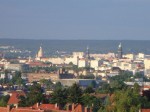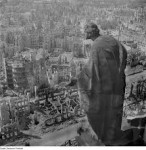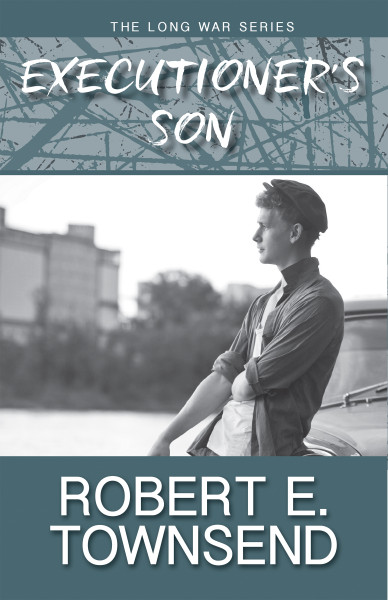Every word she writes is a lie, including ‘and’ and ‘the.’
Mary McCarthy, a New York writer and Trotskyite, speaking of Lillian Hellman, a New York writer and Stalinist, on the Dick Cavett show (January, 1980)
Dresden, Germany

View of Dresden from apartment window, June 2014

Dresden after night of 13-14 Feb 1945 USAAF and RAF bombing and the.
I am in Dresden until late summer. We have rented a fourth floor apartment in Dölzschen, a village a mile SSE in the foothills with an amphitheater view of Dresden’s city center. Often I forget how close the German city is to the German countryside. Though German towns now merge into one another like suburbia in America, this five- or six-hundred year old farm village still, if not for much longer, has a sense of the country. The town hall (rathaus) borders the barn yard (bauerhof). It is as if in the morning and evening cows still walk to pasture down the main street.
Our apartment has high-stadium view of the downtown where the 13-14 February 1945 Dresden firestorm gutted the city. One can almost feel, having finished the milking that evening sixty years ago, the farmer hears the horses, agitated, their heavy hooves striking the pen boards a few times, resonance to the first few bombs the pathfinders dropped to mark the target zone, then the silence, then down along the Elbe River, the city beneath the clouds lights up in fire and explosions. The firestorm killing twenty-five thousand. In the conflagration the innocent, half-innocent and guilty alike perished. Such was the first half of Europe’s twentieth century; 25,000 dead barely registered a blip.
Last night I called a Canadian friend. We had hung together when I lived in Berlin in the early 1970s and we agreed that downtown Dresden, despite post-Communist reconstruction and restoration emanates (for us at least) a sense of that firestorm night. How could that be, or rather how could we feel Dresden’s mass deaths which we hadn’t noticed when we lived in Berlin? USAAF and the RAF bombed Berlin until Konev and Zhukov’s Soviet Army fought block-by-block across the city, then loosed their second echelons to pillage and rape the survivors. My Canadian and our youthful and blithe friends focused on good wine and good times. Any ghosts haunting twentieth century Berlin left us at least in peace.
I’ve written here and here of the memorials dotting the European landscape. It is right and proper to bear witness, to memorialize a nightmare. To render nightmare into story seems to lighten the bearer’s load. Survivors are compelled to memorialize the wretched experience in stone, novel or poem and this is good.

Vonnegut on Dresden “The Dresden atrocity, tremendously expensive and meticulously planned, was so meaningless, finally, that only one person on the entire planet got any benefit from it. I am that person. I wrote this book, which earned a lot of money for me and made my reputation, such as it is. One way or another, I got two or three dollars for every person killed. Some business I’m in.”

Victor Klemperer, a Jew (cousin to symphony conductor, Otto Klemperer) and decade long witness to Nazi persecution, survived the firestorm and, because of the allied bombing of Dresden, survived the Nazi genocide. On February 13, 1945, the Gestapo gave Klemperer the deportation orders (Theresienstadt) to deliver to the last Jews of Dresden. In the post air raid chaos, Klemperer tore off his yellow star, joined refugee columns west and survived the war. His published journals articulate the decade of constant persecution, the Theriesenstadt death camp a few miles down the road.
Pre-WWII, Dresden was truly a beautiful and elegant memorial to the best of Baroque architecture harmonized one great building with its neighbor. Post WWII, Dresden bombing became a Western anti-war cause celebré in no small part because the before-and-after smoke-blackened photos of marble nymphs and angels, made powerful visual impact upon the blithe, innocent and ignorant.
Kurt Vonnegut, author of Slaughterhouse Five, experienced the Dresden bombing a US POW, the experience burned into his spiritual retina. But where he waxed bitter and indignant, others saw nuance and difference even in area bombing.
Victor Klemperer, his house just down the street from me and buried the Dolzschen Friedhof, survived the Dresden firestorm, and in the resultant confusion, survived the German annihilation of European Jewry, his journals an eye-witness to ten-year Nazi campaign to annihilate European Jewry.
If one must fall to one side or the other, I fall to Klemperer’s side; my father, an Army infantryman in the Pacific War from New Caledonia to Okinawa, was to have been on first wave of the invasion of Kyushu. General George C. Marshall expected one million American casualties; Hiroshima and Nagasaki saved those American lives and millions of Japanese lives.
So, though Vonnegut take on his bad night in Dresden might make him seem a self-loathing twit in comparison to Victor Klemperer’s decade-long death watch, it was Vonnegut’s own near-death experience, and he had to somehow make sense of it, however he could. He owned his nightmare; he’d either fix it, or he wouldn’t. It appears he did. He wrote Slaughterhouse Five.
I suppose I am on my own pilgrimage this year. Save for two tours in Vietnam, a callow twenty-three-year old lieutenant, my military life was spent in, devoted to, or in some way circled around Central Europe. I defended Germany against the Soviet Union. I am not unaware that the word ‘defend’ was euphemistic. I wrote NATO war plans; I analyzed Soviet war plans. Both war plans imagined the war in Germany and WWII would have been as the prelude to Gotterdammerung, The Twilight of the Gods, to the WWIII my colleagues, Soviet and American, planned to fight across the beautiful countryside.
Also dann, schreiben wir weiter, gel?
————————————————————–
According to official German report Tagesbefehl (Order of the Day) no. 47 (“TB47”) issued on 22 March the number of dead recovered by that date was 20,204, including 6,865 who were cremated on the Altmarkt square, and the total number of deaths was expected to be about 25,000. Goebbles seems to have added a zero, i.e., 200,000, which, for many, became a ‘truth.’ Death toll estimates as high as 500,000 have been given.[10]







